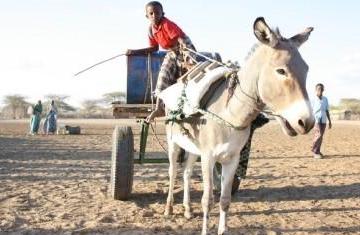
Above: More than 23 million people are being pushed towards
severe hunger and destitution across East Africa, international
aid agency Oxfam warned today, as it launched an emergency
appeal to raise $15 million. In Ethiopia, 13.7 million people are
at risk.
Oxfam’s deputy humanitarian director says the famine is
reaching a “tipping point”. Watch the video on BBC.
Source: Oxfam International
A severe and persistent five-year drought, deepened by climate change, is now stretching across seven countries in the region and exacting a heavy human toll, made worse by high food prices and violent conflict. The worst affected countries are Kenya, Ethiopia, Somalia and Uganda. Other countries hit are Sudan, Djibouti and Tanzania.
Malnutrition is now above emergency levels in some areas and hundreds of thousands of cattle – people’s key source of income – are dying. This is the worst drought that Kenya has experienced for a decade, and the worst humanitarian situation Somalia has experienced since 1991.
The high numbers of people affected – more than double the number caught up in similar food crisis in 2006, when 11 million were at risk – underline the gravity of the situation and the urgent need for funding to prevent the crisis getting worse.
Paul Smith Lomas, Oxfam’s East Africa Director said:
“This is the worst humanitarian crisis Oxfam has seen in East Africa for over ten years. Failed and unpredictable rains are ever more regular across East Africa as raining seasons shorten due to the growing influence of climate change. Droughts have increased from once a decade to every two or three years. In Wajir, northern Kenya, almost 200 dead animals were recently found around one dried-up water source. People are surviving on 2 liters of water a day in some places – less water than a toilet flush. The conditions have never been so harsh or so inhospitable, and people desperately need our help to survive.”
In Kenya , 3.8 million, a tenth of the population, are in need of emergency aid. Food prices have spiraled to 180 percent above average. Areas such as Rift Valley, which have never previously experienced a drought of this intensity are now affected. Conflict over rapidly diminishing resources such as water and pasture for cattle is increasing. Desperate herders are taking their cattle further to look for water and food, sparking tensions with other groups competing for the same resources. Sixty-five people have been killed in Turkana, northern Kenya since June 2009.
One in six children are acutely malnourished in Somalia , and people are trekking for days to find water in the northern regions of the country. Conflict means that people are less able to grow the food, and drought is creating hardship in areas where people have fled. Half of the population – over 3.8 million people – are affected.
In Ethiopia, 13.7 million people are at risk of severe hunger and need assistance. Many are selling their cattle to buy food. In northern Uganda farmers have lost half of their crops and more than 2 million people across the country desperately need aid.
Some 160,000 people mainly around the wild life tourist area of Ngorongoro in north-eastern Tanzania are also at risk. In Djibouti there are worrying levels of increased malnutrition and in South Sudan conflict has put 88,000 people at particular risk.
The aid response to the crisis needs to rapidly expand, but it is desperately short of funds. The World Food Program is facing a $977 million donor shortfall for its work in the Horn of Africa over the next six months. The government of Uganda appealed for donor money to tackle the food crisis, but has so far received only 50 percent of the funding it needs.
Rains are due in October but are likely to bring scant relief or worse still, deluges that could dramatically worsen the situation. There are genuine fears that the region could be hit by floods as a result of the El Nino phenomenon, which could destroy crops and houses, and increase the spread of water-borne diseases. Even with normal rain, the harvest will not arrive until early 2010. People will still need aid to get them through a long hunger season.
Oxfam staff are on the ground helping those at risk but the organisation is appealing for help from the UK public to help scale up its efforts. The agency is expanding its aid effort to reach more than 750,000 people but is in desperate need for funds to do this work. Oxfam is supplying emergency clean water and access to food, and also carrying out long-term projects to strengthen people’s ability to cope with future shocks.


























1 Response to “23 million East Africans at risk of hunger”